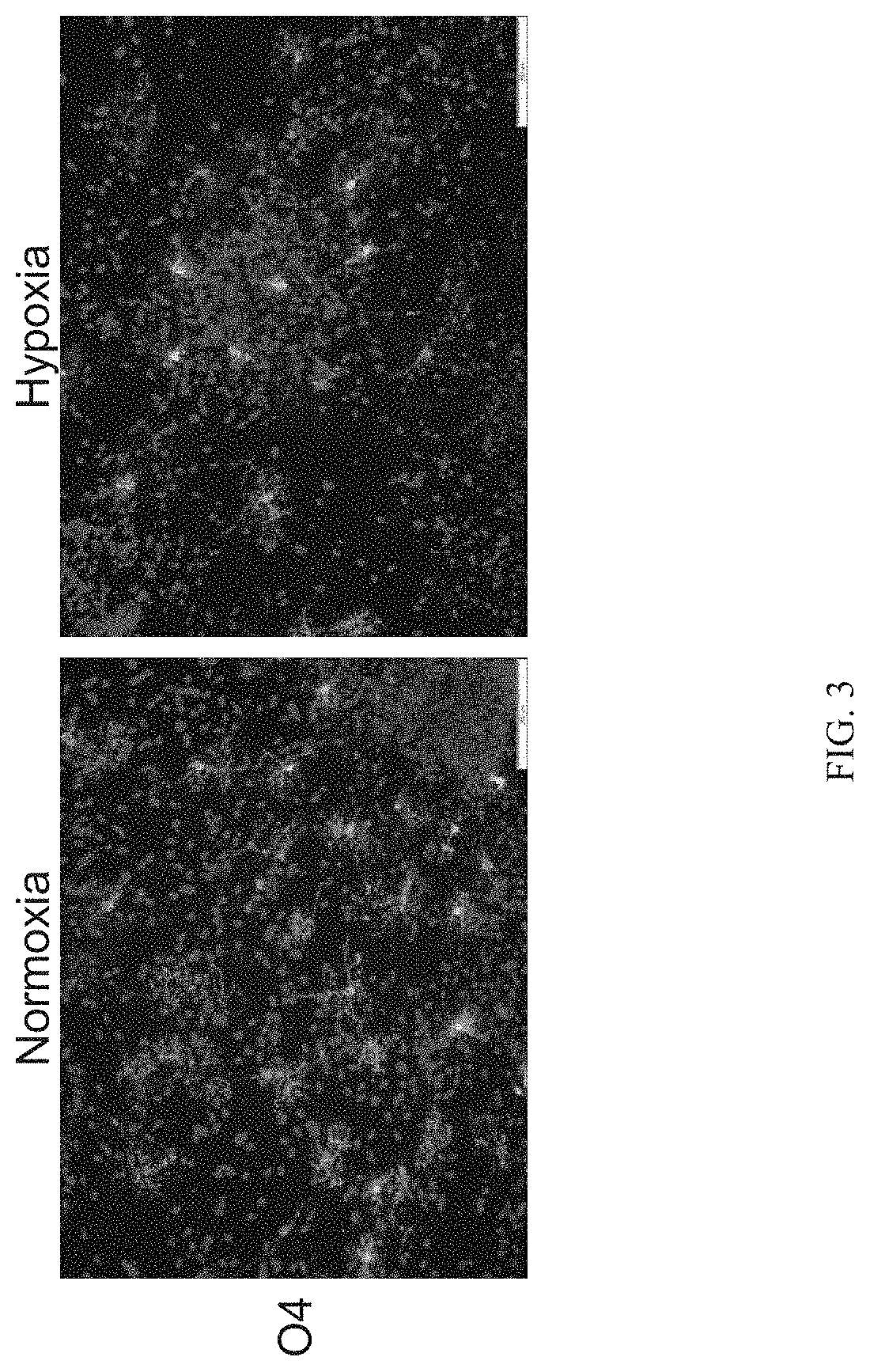Methods of generating oligodendrocytes
a technology of oligodendrocytes and oligodendrocytes, which is applied in the direction of instruments, peptide/protein ingredients, immunological disorders, etc., can solve the problems of cerebral palsy, nervous system and developmental problems, and the greatest risk of premature babies
- Summary
- Abstract
- Description
- Claims
- Application Information
AI Technical Summary
Benefits of technology
Problems solved by technology
Method used
Image
Examples
example 1
REFERENCES FOR EXAMPLE 1
[0200]1] S. R. L. Stacpoole et al., “High Yields of Oligodendrocyte Lineage Cells from Human Embryonic Stem Cells at Physiological Oxygen Tensions for Evaluation of Translational Biology,”Stem Cell Reports, vol. 1, no. 5, pp. 437-450, November 2013.[0201][2] P. Douvaras et al., “Efficient Generation of Myelinating Oligodendrocytes from Primary Progressive Multiple Sclerosis Patients by Induced Pluripotent Stem Cells,”Stem Cell Reports, vol. 3, no. 2, pp. 250-259, August 2014.[0202][3] B.-Y. Hu, Z.-W. Du, and S.-C. Zhang, “Differentiation of human oligodendrocytes from pluripotent stem cells,”Nat. Protoc., vol. 4, no. 11, pp. 1614-1622, November 2009.[0203][4] S. Wang et al., “Human iPSC-Derived Oligodendrocyte Progenitor Cells Can Myelinate and Rescue a Mouse Model of Congenital Hypomyelination,”Cell Stem Cell, vol. 12, no. 2, pp. 252-264, February 2013.[0204][5] M. Izrael et al., “Human oligodendrocytes derived from embryonic stem cells: Effect of noggin on ...
example 2
Analysis of the Therapeutic Effect of MEK / ERK Inhibitors in an Animal Model of Hypoxia Induced WMI
[0212]Pregnant C57 / B mice will be monitored daily to determine the time of littering. At P3, dams and their pups will be randomly assigned (the pups' sexing not relevant in this study) to control or test groups and will be transferred in their cages for housing in a plexiglas oxygen-monitored chamber. The hypoxia-induced group will have 10% oxygen while the normoxia group will have normal oxygen conditions (˜21%). The pups in the hypoxia-induced group will be daily treated with either PD0325901 (5 mg / kg) or Trametinib (5 mg / Kg) according to body weight, by oral gavage, from P3-P10 during hypoxia induction or from P11-P18 after hypoxia induction, or from P3-P18. From P11 all animals will have normal oxygen condition (˜21%). At P10, P18 and P40, pups will be sacrificed for histology analysis. At P40, the pups will undergo rotarod and beam walking motor function tests.
[0213]An outline of t...
example 3
ICV Delivery of PD0325901 (PD) for Treatment of Chronic EAE
[0214]The Biozzi mouse model of Multiple Sclerosis: Biozzi ABH mice have genetic tendency to develop autoimmune diseases, and are used for many autoimmune models. The experimental autoimmune model in Biozzi mice is induced by immunization with spinal cord homogenate. Typically, mice develop an acute relapse, followed by remission, and after that a relapsing and progressive course of disease, resembling human multiple sclerosis (MS). Pathologically these mice exhibit typical features of human MS, including lesions of demyelination with variable degrees of axonal injury, in association with a neuroinflammatory process of T-cell and B-cell infiltration, microgliosis and astrogliosis. In the chronic phase of EAE there are typical immunopathological features resembling progressive MS, such as meningeal infiltrates and development of tertiary lymphoid-like tissue, partial closing of the blood-brain-barrier, and reduction in lesion...
PUM
| Property | Measurement | Unit |
|---|---|---|
| body weight | aaaaa | aaaaa |
| time | aaaaa | aaaaa |
| ultrasound | aaaaa | aaaaa |
Abstract
Description
Claims
Application Information
 Login to View More
Login to View More - R&D
- Intellectual Property
- Life Sciences
- Materials
- Tech Scout
- Unparalleled Data Quality
- Higher Quality Content
- 60% Fewer Hallucinations
Browse by: Latest US Patents, China's latest patents, Technical Efficacy Thesaurus, Application Domain, Technology Topic, Popular Technical Reports.
© 2025 PatSnap. All rights reserved.Legal|Privacy policy|Modern Slavery Act Transparency Statement|Sitemap|About US| Contact US: help@patsnap.com



